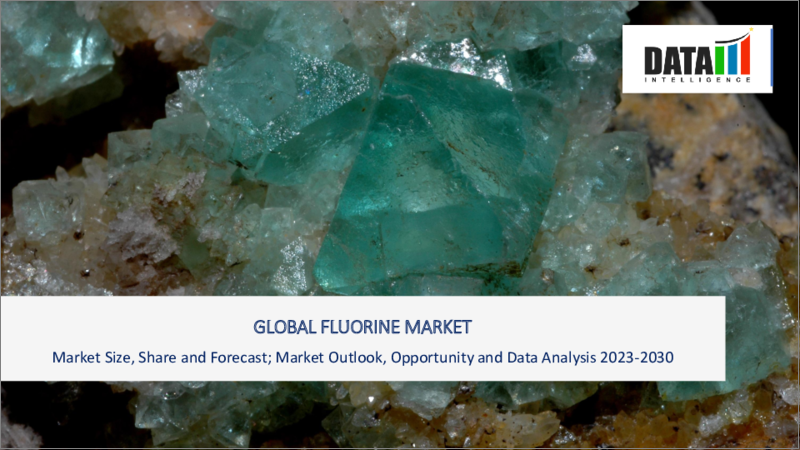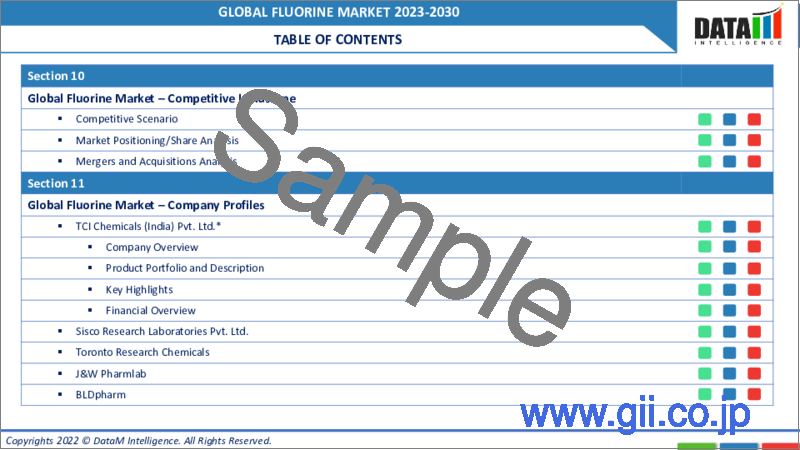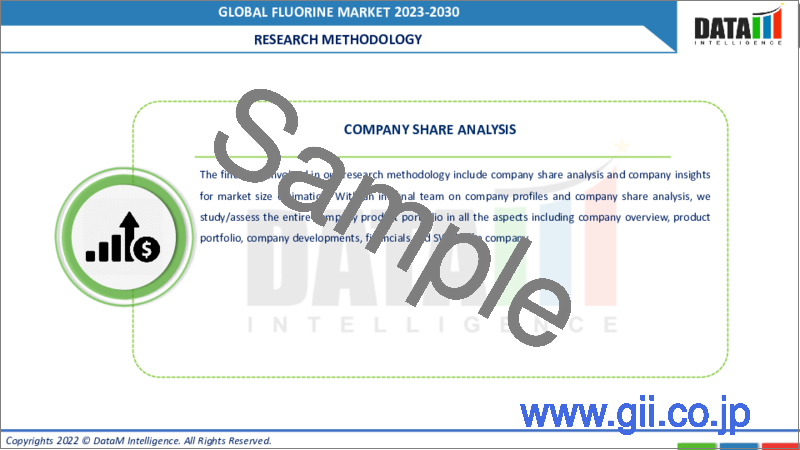|
|
市場調査レポート
商品コード
1279699
フッ素の世界市場-2023-2030Global Fluorine Market - 2023-2030 |
||||||
カスタマイズ可能
適宜更新あり
|
|||||||
| フッ素の世界市場-2023-2030 |
|
出版日: 2023年05月26日
発行: DataM Intelligence
ページ情報: 英文 162 Pages
納期: 即日から翌営業日
|
- 全表示
- 概要
- 目次
市場の概要
世界のフッ素市場は、2022年に10億6,730万米ドルに達し、2030年には12億4,780万米ドルまで達すると予測されています。同市場は予測期間(2023-2030年)にCAGR 4.2%で成長しています。
世界のフッ素市場は、アルミニウム生産、冷凍、化学産業など複数の産業におけるフッ素系製品の需要増加など、さまざまな市場促進要因によって、近年大きな成長を遂げています。政府筋によると、多くのフッ素系製品の主要な構成要素であるフッ化水素酸は、2022年のフッ素系化学品の総生産量および市場シェアの約75%を占めています。さらに、フッ素樹脂やフッ素系ガスなどのフッ素系製品は、さまざまな用途で幅広く使用されているため、市場動向は上昇傾向にあります。
また、電気自動車などのハイテク用途に広く使用されるリチウムイオン電池の需要増に伴い、フッ素の市場機会は拡大しています。リチウムイオン電池の主成分であるフッ化水素酸の需要は今後増加することが予想され、フッ素市場に新たな市場機会を創出しています。さらに、航空宇宙産業や自動車産業でフッ素系製品が使用される傾向が強まっており、今後数年間の市場成長を牽引すると予想されます。新たな市場機会の創出と革新的な技術の開発により、フッ素市場の将来は有望であると考えられます。
市場力学
フッ素製品への需要の高まり
世界のフッ素市場の最大の促進要因は、アルミニウム製造、冷凍、化学工業など、さまざまな産業におけるフッ素系製品の需要拡大です。また、自動車産業や航空宇宙産業、電気自動車用リチウムイオン電池の製造など、ハイテク分野でもフッ素系製品の使用が増加しています。米国地質調査所(USGS)によると、フッ化水素酸は世界で消費される最も重要なフッ素系化学品で、フッ素系化学品総生産量の約75%を占めています。フッ化水素酸は、冷媒、プラスチック、医薬品、アルミニウムなど、多くのフッ素系製品の重要な構成要素となっています。フッ化水素酸の需要は、これらの産業での使用や、リチウムイオン電池の製造における役割によって牽引されています。結論として、フッ素の世界市場シェアの最大の要因は、さまざまな産業におけるフッ素系製品の需要拡大、特に多くのフッ素系製品の主要な構成要素であるフッ化水素酸の需要拡大です。
フッ素製品の使用と廃棄に関する環境規制と懸念
世界のフッ素市場の最大の抑制要因の一つは、フッ素製品の使用と廃棄に関する環境規制と懸念です。米国環境保護庁(EPA)は、フッ素系ガスの大気中への放出の可能性、水や土壌の汚染、人間や野生動物への健康影響の可能性など、フッ素系製品の使用や廃棄に関するいくつかの懸念を挙げています。また、EPAは、フッ素系製品を含むオゾン層破壊物質の安全な代替物質を特定し、その使用を促進するSNAP(Significant New Alternatives Policy)プログラムなどの規制を実施しています。
これらの規制や懸念は、フッ素市場の主要製品であるフッ化水素酸、冷媒、フッ素樹脂などのフッ素系製品の生産と需要に影響を与える可能性があります。それでも、世界のフッ素市場が持続的に成長するためには、これらの環境懸念を緩和し、規制要件を満たすことができる、新しく革新的な技術やプロセスの開拓が必要です。
COVID-19影響分析
COVID-19の分析には、Pre-COVIDシナリオ、COVIDシナリオ、Post-COVIDシナリオがあり、価格ダイナミクス(パンデミック時およびパンデミック後の価格変動とCOVID前のシナリオとの比較)、需要-供給スペクトラム(取引制限、ロックダウンおよびその後の問題による需要と供給のシフト)、政府の取り組み(政府機関による市場、セクター、産業の活性化に関する取り組み)、メーカーの戦略的取り組み(メーカーはCOVID問題を軽減するために何を行ったのか)も含まれています。
目次
第1章 調査手法とスコープ
- 調査手法
- 調査目的および調査範囲
第2章 定義と概要
第3章 エグゼクティブサマリー
- 製品別スニペット
- スニペット:アプリケーション別
- 地域別スニペット
第4章 市場力学
- 影響要因
- 促進要因
- フッ素系製品の需要拡大
- 抑制要因
- フッ素系製品の使用と廃棄に関する環境規制と懸念
- 機会
- 影響分析
- 促進要因
第5章 産業分析
- ポーターのファイブフォース分析
- サプライチェーン分析
- 価格分析
- 法規制の分析
第6章 COVID-19の分析
- COVID-19の分析
- COVID-19の前のシナリオ
- COVID-19期間中のシナリオ
- COVID-19後のシナリオ、または将来のシナリオ
- COVID-19の中での価格・ダイナミクス
- 需給スペクトル
- パンデミック時の市場に関連する政府の取り組み
- メーカーの戦略的な取り組み
- サマリー
第7章 製品別
- フルオライト
- 氷晶石
- フルオラパタイト
第8章 用途別
- 合成化学材料
- 医薬品
- 殺虫剤
- プラスチック
- 電子部品洗浄
- その他
第9章 地域別
- 北米
- 米国
- カナダ
- メキシコ
- 欧州
- ドイツ
- 英国
- フランス
- イタリア
- ロシア
- その他欧州
- 南米
- ブラジル
- アルゼンチン
- その他南米地域
- アジア太平洋地域
- 中国
- インド
- 日本
- オーストラリア
- その他アジア太平洋地域
- 中東・アフリカ地域
第10章 競合情勢
- 競合シナリオ
- 市況/シェア分析
- M&A(合併・買収)分析
第11章 企業プロファイル
- ADCO Global Inc
- 会社概要
- 製品ポートフォリオと説明
- 財務概要
- 主な発展状況
- ACE Geosynthetics Enterprise Co., Ltd
- Aiello Chemical Co. Ltd
- Solvay
- Linde plc
- Air Liquide S.A
- AGC Inc
- Central Glass Co., Ltd
- Hyosung Chemical
- Zhuoxi Gas
第12章 付録
Market Overview
The global fluorine market reached US$ 1,067.3 million in 2022 and is projected to witness lucrative growth by reaching up to US$ 1,247.8 million by 2030. The market is growing at a CAGR of 4.2% during the forecast period (2023-2030).
The global fluorine market has been experiencing significant growth in recent years, driven by various market drivers such as the increasing demand for fluorinated products in several industries, including aluminum production, refrigeration, and the chemical industry. According to government sources, hydrofluoric acid, a key building block for many fluorinated products, accounted for approximately 75% of the total fluorine chemical production and market share in 2022. Furthermore, the market trend for fluorinated products, such as fluoropolymers and fluorinated gases, is on the rise due to their extensive use in a variety of applications.
The market opportunities for the fluorine market are also expanding with the increasing demand for lithium-ion batteries, which are widely used in electric vehicles and other high-tech applications. The demand for hydrofluoric acid, a key component in lithium-ion batteries, is expected to rise in the coming years, creating new market opportunities for the fluorine market. Additionally, the growing trend toward the use of fluorinated products in the aerospace and automotive industries is expected to drive market growth in the coming years. With new market opportunities emerging and innovative technologies being developed, the future of the fluorine market looks promising.
Market Dynamics
The Growing Demand For Fluorinated Products
The biggest driver for the global fluorine market is the growing demand for fluorinated products in various industries, including aluminum production, refrigeration, and the chemical industry. The use of fluorine-based products is also increasing in the automotive and aerospace industries, as well as in the production of lithium-ion batteries for electric vehicles and other high-tech applications. According to the United States Geological Survey (USGS), hydrofluoric acid is the most important fluorine chemical consumed worldwide, accounting for approximately 75% of the total fluorine chemical production. Hydrofluoric acid is a key building block for many fluorinated products, including refrigerants, plastics, pharmaceuticals, and aluminum. The demand for hydrofluoric acid is driven by its use in these industries, as well as its role in the production of lithium-ion batteries. In conclusion, the biggest driver for the global fluorine market share is the growing demand for fluorinated products in various industries, especially the demand for hydrofluoric acid, which is a key building block for many fluorinated products.
Environmental Regulations And Concerns Regarding The Use And Disposal Of Fluorinated Products
One of the biggest restraints for the global fluorine market is environmental regulations and concerns regarding the use and disposal of fluorinated products. The US Environmental Protection Agency (EPA) lists several concerns regarding the use and disposal of fluorinated products, including the potential release of fluorinated gases into the atmosphere, the contamination of water and soil, and the potential health effects on humans and wildlife. The EPA has also implemented regulations such as the Significant New Alternatives Policy (SNAP) program, which identifies and promotes the use of safer alternatives to ozone-depleting substances, including fluorinated products.
These regulations and concerns can impact the production and demand for fluorinated products, including hydrofluoric acid, refrigerants, and fluoropolymers, which are key products in the fluorine market. Nonetheless, the development of new and innovative technologies and processes that can mitigate these environmental concerns and meet regulatory requirements is necessary to ensure the sustainable growth of the global fluorine market.
COVID-19 Impact Analysis
The COVID-19 analysis includes Pre-COVID Scenario, COVID Scenario and Post-COVID Scenario along with pricing dynamics (including pricing change during and post-pandemic comparing it with pre-COVID scenarios), demand-supply spectrum (shift in demand and supply owing to trading restrictions, lockdown and subsequent issues), government initiatives (initiatives to revive market, sector or industry by government bodies) and manufacturers strategic initiatives (what manufacturers did to mitigate the COVID issues will be covered here).
Segment Analysis
The global fluorine market is segmented based on product, application and region.
The Use Of Fluorspar In The Production Of Hydrofluoric Acid, Which Is A Key Building Block For Many Fluorinated Products
According to the United States Geological Survey (USGS), fluorspar accounted for approximately 64% of global fluorine production in 2020. The use of fluorspar in the production of hydrofluoric acid, which is a key building block for many fluorinated products, is one of the main drivers of its market share in the fluorine market. The USGS also reports that China is the largest producer of fluorspar globally, accounting for approximately 50% of the world's production in 2020. Other significant producers of fluorspar include Mexico, Mongolia, South Africa, and Russia, among others.
The demand for fluorspar in the global market is driven by several factors, including the growing demand for fluorinated products in various industries, including aluminum production, refrigeration, and pharmaceuticals. The use of fluorspar in the production of lithium-ion batteries, which are used in electric vehicles and other high-tech applications, is also expected to increase in the coming years, further driving the market share of fluorspar in the global fluorine market.
Geographical Analysis
The Growing Demand For Fluorinated Products In Industries Such As Chemicals, Electronics, And Pharmaceuticals
The North American fluorine market occupies around 22% of the global fluorine market, which is expected to experience strong growth in the coming years. The North American fluorine market is driven by several factors, including the growing demand for fluorinated products in industries such as chemicals, electronics, and pharmaceuticals. The use of fluorine in refrigerants and air conditioning systems is also a significant driver of the market, as there is a growing need for more environmentally friendly alternatives to traditional refrigerants.
The U.S. is the largest consumer of fluorine in North America, accounting for the majority of the regional market share. The demand for fluorine in the country is driven by the chemical industry, which uses the element in the production of a range of products, including pharmaceuticals, plastics, and solvents. The electronics industry is also a significant consumer of fluorine, as it is used in the production of semiconductors and other electronic components.
Competitive Landscape
The major global players include: ADCO Global Inc, ACE Geosynthetics Enterprise Co., Ltd, Aiello Chemical Co. Ltd, Solvay, Linde plc, Air Liquide S.A, AGC Inc, Central Glass Co., Ltd, Hyosung Chemical and Zhuoxi Gas.
Why Purchase the Report?
- To visualize the global fluorine market segmentation based on product, application and region, as well as understand key commercial assets and players.
- Identify commercial opportunities by analyzing trends and co-development.
- Excel data sheet with numerous data points of fluorine market-level with all segments.
- PDF report consists of a comprehensive analysis after exhaustive qualitative interviews and an in-depth study.
- Product mapping is available in Excel consisting of key products of all the major players.
The global fluorine market report would provide approximately 53 tables, 50 figures and 162 Pages.
Target Audience 2023
- Manufacturers/ Buyers
- Industry Investors/Investment Bankers
- Research Professionals
- Emerging Companies
Table of Contents
1. Methodology and Scope
- 1.1. Research Methodology
- 1.2. Research Objective and Scope of the Report
2. Definition and Overview
3. Executive Summary
- 3.1. Snippet by Product
- 3.2. Snippet by Application
- 3.3. Snippet by Region
4. Dynamics
- 4.1. Impacting Factors
- 4.1.1. Drivers
- 4.1.1.1. The growing demand for fluorinated products
- 4.1.2. Restraints
- 4.1.2.1. Environmental regulations and concerns regarding the use and disposal of fluorinated products
- 4.1.3. Opportunity
- 4.1.4. Impact Analysis
- 4.1.1. Drivers
5. Industry Analysis
- 5.1. Porter's Five Forces Analysis
- 5.2. Supply Chain Analysis
- 5.3. Pricing Analysis
- 5.4. Regulatory Analysis
6. COVID-19 Analysis
- 6.1. Analysis of COVID-19
- 6.1.1. Scenario Before COVID-19
- 6.1.2. Scenario During COVID-19
- 6.1.3. Post COVID-19 or Future Scenario
- 6.2. Pricing Dynamics Amid COVID-19
- 6.3. Demand-Supply Spectrum
- 6.4. Government Initiatives Related to the Market During Pandemic
- 6.5. Manufacturers Strategic Initiatives
- 6.6. Conclusion
7. By Product
- 7.1. Introduction
- 7.1.1. Market Size Analysis and Y-o-Y Growth Analysis (%), By Product
- 7.1.2. Market Attractiveness Index, By Product
- 7.2. Fluorite*
- 7.2.1. Introduction
- 7.2.2. Market Size Analysis and Y-o-Y Growth Analysis (%)
- 7.3. Cryolite
- 7.4. Fluorapatite
8. By Application
- 8.1. Introduction
- 8.1.1. Market Size Analysis and Y-o-Y Growth Analysis (%), By Application
- 8.1.2. Market Attractiveness Index, By Application
- 8.2. Synthetic Chemical Materials*
- 8.2.1. Introduction
- 8.2.2. Market Size Analysis and Y-o-Y Growth Analysis (%)
- 8.3. Pharmaceuticals
- 8.4. Pesticides
- 8.5. Plastic
- 8.6. Electronic Cleaning
- 8.7. Others
9. By Region
- 9.1. Introduction
- 9.1.1. Market Size Analysis and Y-o-Y Growth Analysis (%), By Region
- 9.1.2. Market Attractiveness Index, By Region
- 9.2. North America
- 9.2.1. Introduction
- 9.2.2. Key Region-Specific Dynamics
- 9.2.3. Market Size Analysis and Y-o-Y Growth Analysis (%), By Product
- 9.2.4. Market Size Analysis and Y-o-Y Growth Analysis (%), By Application
- 9.2.5. Market Size Analysis and Y-o-Y Growth Analysis (%), By Country
- 9.2.5.1. The U.S.
- 9.2.5.2. Canada
- 9.2.5.3. Mexico
- 9.3. Europe
- 9.3.1. Introduction
- 9.3.2. Key Region-Specific Dynamics
- 9.3.3. Market Size Analysis and Y-o-Y Growth Analysis (%), By Product
- 9.3.4. Market Size Analysis and Y-o-Y Growth Analysis (%), By Application
- 9.3.5. Market Size Analysis and Y-o-Y Growth Analysis (%), By Country
- 9.3.5.1. Germany
- 9.3.5.2. The U.K.
- 9.3.5.3. France
- 9.3.5.4. Italy
- 9.3.5.5. Russia
- 9.3.5.6. Rest of Europe
- 9.4. South America
- 9.4.1. Introduction
- 9.4.2. Key Region-Specific Dynamics
- 9.4.3. Market Size Analysis and Y-o-Y Growth Analysis (%), By Product
- 9.4.4. Market Size Analysis and Y-o-Y Growth Analysis (%), By Application
- 9.4.5. Market Size Analysis and Y-o-Y Growth Analysis (%), By Country
- 9.4.5.1. Brazil
- 9.4.5.2. Argentina
- 9.4.5.3. Rest of South America
- 9.5. Asia-Pacific
- 9.5.1. Introduction
- 9.5.2. Key Region-Specific Dynamics
- 9.5.3. Market Size Analysis and Y-o-Y Growth Analysis (%), By Product
- 9.5.4. Market Size Analysis and Y-o-Y Growth Analysis (%), By Application
- 9.5.5. Market Size Analysis and Y-o-Y Growth Analysis (%), By Country
- 9.5.5.1. China
- 9.5.5.2. India
- 9.5.5.3. Japan
- 9.5.5.4. Australia
- 9.5.5.5. Rest of Asia-Pacific
- 9.6. Middle East and Africa
- 9.6.1. Introduction
- 9.6.2. Key Region-Specific Dynamics
- 9.6.3. Market Size Analysis and Y-o-Y Growth Analysis (%), By Product
- 9.6.4. Market Size Analysis and Y-o-Y Growth Analysis (%), By Application
10. Competitive Landscape
- 10.1. Competitive Scenario
- 10.2. Market Positioning/Share Analysis
- 10.3. Mergers and Acquisitions Analysis
11. Company Profiles
- 11.1. ADCO Global Inc*
- 11.1.1. Company Overview
- 11.1.2. Product Portfolio and Description
- 11.1.3. Financial Overview
- 11.1.4. Key Developments
- 11.2. ACE Geosynthetics Enterprise Co., Ltd
- 11.3. Aiello Chemical Co. Ltd
- 11.4. Solvay
- 11.5. Linde plc
- 11.6. Air Liquide S.A
- 11.7. AGC Inc
- 11.8. Central Glass Co., Ltd
- 11.9. Hyosung Chemical
- 11.10. Zhuoxi Gas
LIST NOT EXHAUSTIVE
12. Appendix
- 12.1. About Us and Services
- 12.2. Contact Us





